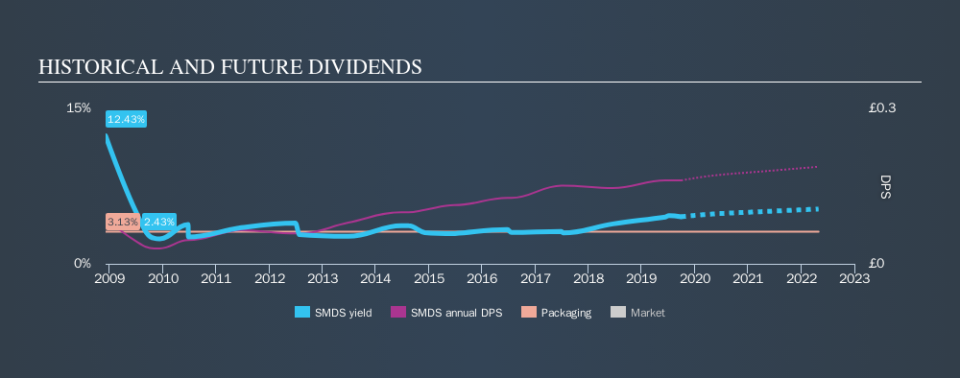Interested In DS Smith Plc (LON:SMDS)’s Upcoming 3.1% Dividend? You Have 2 Days Left

DS Smith Plc (LON:SMDS) is about to trade ex-dividend in the next 2 days. You will need to purchase shares before the 3rd of October to receive the dividend, which will be paid on the 1st of November.
DS Smith's upcoming dividend is UK£0.1 a share, following on from the last 12 months, when the company distributed a total of UK£0.2 per share to shareholders. Based on the last year's worth of payments, DS Smith has a trailing yield of 4.6% on the current stock price of £3.541. If you buy this business for its dividend, you should have an idea of whether DS Smith's dividend is reliable and sustainable. We need to see whether the dividend is covered by earnings and if it's growing.
View our latest analysis for DS Smith
If a company pays out more in dividends than it earned, then the dividend might become unsustainable - hardly an ideal situation. It paid out 82% of its earnings as dividends last year, which is not unreasonable, but limits reinvestment in the business and leaves the dividend vulnerable to a business downturn. We'd be worried about the risk of a drop in earnings. That said, even highly profitable companies sometimes might not generate enough cash to pay the dividend, which is why we should always check if the dividend is covered by cash flow. It paid out 82% of its free cash flow as dividends, which is within usual limits but will limit the company's ability to lift the dividend if there's no growth.
It's positive to see that DS Smith's dividend is covered by both profits and cash flow, since this is generally a sign that the dividend is sustainable, and a lower payout ratio usually suggests a greater margin of safety before the dividend gets cut.
Click here to see the company's payout ratio, plus analyst estimates of its future dividends.
Have Earnings And Dividends Been Growing?
Stocks in companies that generate sustainable earnings growth often make the best dividend prospects, as it is easier to lift the dividend when earnings are rising. If earnings decline and the company is forced to cut its dividend, investors could watch the value of their investment go up in smoke. With that in mind, we're encouraged by the steady growth at DS Smith, with earnings per share up 5.2% on average over the last five years. While earnings have been growing at a credible rate, the company is paying out a majority of its earnings to shareholders. Therefore it's unlikely that the company will be able to reinvest heavily in its business, which could presage slower growth in the future.
We'd also point out that DS Smith issued a meaningful number of new shares in the past year. It's hard to grow dividends per share when a company keeps creating new shares.
Many investors will assess a company's dividend performance by evaluating how much the dividend payments have changed over time. DS Smith has delivered an average of 6.3% per year annual increase in its dividend, based on the past ten years of dividend payments. It's encouraging to see the company lifting dividends while earnings are growing, suggesting at least some corporate interest in rewarding shareholders.
The Bottom Line
Has DS Smith got what it takes to maintain its dividend payments? Earnings per share growth has been unremarkable, and while the company is paying out a majority of its earnings and cash flow in the form of dividends, the dividend payments don't appear excessive. In summary, it's hard to get excited about DS Smith from a dividend perspective.
Ever wonder what the future holds for DS Smith? See what the 12 analysts we track are forecasting, with this visualisation of its historical and future estimated earnings and cash flow
We wouldn't recommend just buying the first dividend stock you see, though. Here's a list of interesting dividend stocks with a greater than 2% yield and an upcoming dividend.
We aim to bring you long-term focused research analysis driven by fundamental data. Note that our analysis may not factor in the latest price-sensitive company announcements or qualitative material.
If you spot an error that warrants correction, please contact the editor at editorial-team@simplywallst.com. This article by Simply Wall St is general in nature. It does not constitute a recommendation to buy or sell any stock, and does not take account of your objectives, or your financial situation. Simply Wall St has no position in the stocks mentioned. Thank you for reading.

 Yahoo Finance
Yahoo Finance 
